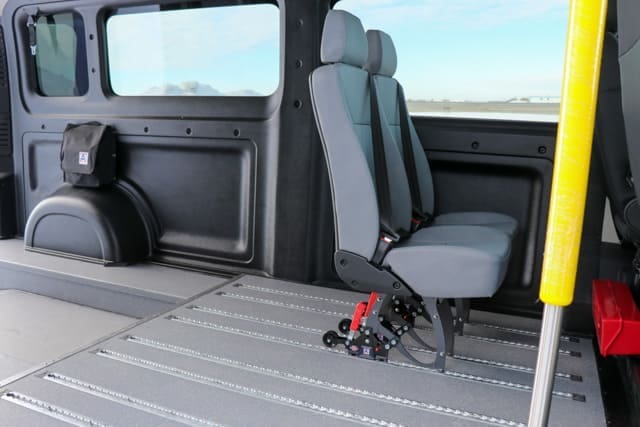Here’s something that might surprise you: About 27% of adults in Canada live with a disability. That’s over 8 million people. Many of them rely on community programs, health services, or support vehicles to get where they need to go.
If your wheelchair accessible vans don’t meet AODA standards, that’s a serious problem. It means people in your community might struggle to access care, get to appointments, or even participate in daily life. That gap can lead to missed services, lower trust in your program, and even legal trouble under the AODA Act, Ontario.
You want to serve people well. But without AODA compliance, your efforts might fall short. The good news? When your vehicles meet the right standards, your team can serve more people, with less stress and more dignity. That’s the outcome you’re aiming for.
At MoveMobility, we’ve been helping organizations across Canada for over 20 years. We build custom vehicles that reduce barriers and save lives. We’ve worked with trusted names like Transdev, and many others like you. We know we’re not the only ones doing this work, but we do it with care, purpose, and heart.
In this article, you’ll learn:
- What AODA stands for and what AODA means
- How the AODA Act applies to your vehicles
- What AODA compliance looks like
- How to meet AODA standards confidently
What does AODA stand for, and what does it mean?
AODA stands for the Accessibility for Ontarians with Disabilities Act. It’s a law in Ontario that’s all about making spaces, services, and transportation easier to access for people with disabilities.
The AODA was passed in 2005 with a big goal: To make Ontario fully accessible by 2025. That means removing barriers in public spaces, websites, hiring practices, customer service, and yes, transportation, too. If your organization runs wheelchair accessible vans or mobile services in Ontario, AODA compliance isn’t optional. It’s the law.
AODA is about giving everyone a fair shot at getting where they need to go, safely and with dignity. If your vehicles are hard to enter, don’t have space for mobility devices, or aren’t designed with real people in mind, you’re creating a barrier, even if you didn’t mean to.
Here’s a quick breakdown to keep things clear:
- AODA meaning: A law that aims to remove barriers for people with disabilities in everyday life.
- Why it exists: To make sure every person in Ontario can access public and private services, spaces, and jobs.
- Who it affects: All organizations in Ontario, including non-profits, healthcare groups, municipalities, and private companies.
- Where it applies: Physical spaces, websites, hiring processes, service delivery, and transportation.
So, if you’re buying a wheelchair van for your program, you’re probably wondering, “What do I need to do to follow the AODA Act, Ontario?“
Good news, we’ll walk you through it. Understanding what AODA standards are is the first step to closing the gap and reaching more people.
How does AODA apply to wheelchair vans?
So, now that you know what AODA stands for, let’s talk about how it actually affects your program, especially if you use wheelchair vans.
If your organization provides rides for people in Ontario, then AODA compliance isn’t just nice to have. It’s a legal must. That includes everything from how riders book trips to how easy it is for someone using a walker or wheelchair to enter and exit the vehicle.

Here’s what AODA means for your vans:
- Accessible design: Your vans should have wide enough doors, secure wheelchair restraints, grab bars, and proper ramp or lift access.
- Safe use: Passengers must be able to board, ride, and exit safely without feeling like an afterthought.
- Reliable service: Riders with disabilities should get the same level of service as anyone else. That means timely pickups, trained drivers, and dependable scheduling.
If you miss the mark here, you could end up with frustrated riders, complaints, or worse, penalties under the AODA Act in Ontario. You might even lose funding if your vans don’t meet AODA standards.
Let’s say you’re running a community health shuttle. If someone can’t get on your vehicle because the ramp is too steep or there’s no space for their wheelchair, that’s a problem. It doesn’t just impact their day—it affects their health, access to services, and trust in your program.
Bottom line: AODA applies to any organization that provides transportation in Ontario. Whether it’s a single van or a full fleet, those vehicles need to meet the standards set out in the Ontarians with Disabilities Act AODA.
Next up, we’ll look at the actual rules.
What are the AODA standards for accessible transportation?
If you provide transportation services in Ontario, there are specific rules under the AODA Act that you need to follow. These rules are part of the Integrated Accessibility Standards Regulation (IASR), and they help make sure people with disabilities can travel safely and comfortably.
These aren’t general suggestions; they’re legal requirements that apply to your wheelchair vans if your organization transports the public or specific groups like patients or clients.
Your van must include
- Lifts or ramps: These must have anti-slip surfaces and side guards to prevent mobility devices from rolling off.
- Clear interior space: You need a minimum of 1,220 mm by 760 mm of floor space to safely fit most wheelchairs or scooters.
- Wheelchair restraint systems: These secure mobility devices to the floor so they don’t move during travel.
- Passenger safety belts: Each mobility spot must have lap and shoulder belts for safe and secure transport.
- High-contrast markings: Steps, handrails, and ramps should be clearly marked for people with vision impairments.
How you operate also matters
- Accessible communication: Riders must be able to request accessible formats like large print or audio.
- Support persons ride free: If a passenger needs a support person, your organization can’t charge for that extra seat.
- Staff assistance: Drivers must help passengers board and exit when needed.
- Priority seating: These seats must be clearly labeled and kept available for passengers with disabilities.
Driver training requirements
Drivers and staff need to know:
- How to properly use accessibility equipment
- How to safely support riders with physical or cognitive disabilities
- What to do in emergencies involving a rider with a disability
Additional AODA standards for transportation
- Service animals: Riders must be allowed to bring service animals on board without extra fees or restrictions.
- Accessible booking: Your booking system (phone, online, or in person) must be easy to use for people with disabilities. That means offering multiple ways to book and clear, helpful information.
- Notice of temporary disruptions: If an accessibility feature (like a lift or ramp) is out of order, you must notify passengers quickly and offer alternative solutions.
- Feedback process: Your organization must have a way for passengers to share accessibility concerns or complaints and respond in a timely manner.
Following these AODA standards builds trust, reduces risk, and helps your team deliver safe, reliable service.
What happens if you don’t meet AODA compliance?
Ignoring AODA compliance can cause serious problems for your organization. When your wheelchair vans or transportation services don’t follow the rules, you risk more than just a warning letter.
Here’s what can happen:
- Fines and penalties: If your organization doesn’t meet AODA standards, the government can charge it thousands of dollars, which can add up fast.
- Lost funding: Many grants and contracts require proof of AODA compliance. Missing this can mean losing money you rely on.
- Legal action: People who face barriers because of inaccessible services might take legal steps against your organization.
- Damage to reputation: Word spreads fast. If your service isn’t accessible, you could lose the trust of the community and partners.
- Missed opportunities: Without accessible vans, you limit who you can serve, shrinking your impact and reach.
Most importantly, gaps in accessibility create real barriers for people with disabilities. When someone can’t get the ride they need, it affects their health, independence, and quality of life.
Acting early to meet AODA compliance helps you avoid these risks, shows you care about the people you serve, and strengthens and expands your program.
In the next section, we’ll discuss practical steps you can take to ensure your vehicles meet AODA standards and close those gaps permanently.
5 steps you can take to make sure your wheelchair van meets AODA standards
Getting your wheelchair van ready to meet AODA standards might seem like a big job. Breaking it down helps. The first and most important step is working with the right partner.
1. Work with a reputable manufacturer who knows AODA inside and out
Choose a manufacturer that follows the AODA Act closely and builds vans to meet all accessibility rules.
This means:
- They include ramps or lifts that follow safety and size rules.
- They install secure wheelchair tie-downs and proper seat belts.
- They design vehicles with enough space for mobility devices.
- They train their team on AODA standards and keep up with changes.
A manufacturer that listens to your unique needs saves you time, money, and future headaches. At MoveMobility, we focus on building custom wheelchair vans and mobile medical units that meet or beat AODA compliance.
2. Train your drivers and staff on accessibility best practices
Having an AODA-compliant van is only part of the equation. Your drivers and staff need to know how to use the vehicle’s accessibility features and interact respectfully with passengers who have disabilities.
Here’s what training should cover:
- Operating lifts, ramps, and securement systems safely
- Helping passengers board and exit without rushing or assuming
- Communicating clearly and patiently
- Understanding different types of disabilities and needs
- Responding calmly in emergencies involving passengers with disabilities
Well-trained staff make your service safer and more welcoming. It also shows your organization truly cares about accessibility.
When everyone on your team knows the right way to support riders, your program runs smoother and builds trust in the community.
3. Create clear policies and communication for accessibility
Having good rules and clear communication helps your whole program run better and keeps you on track with AODA compliance.
Here’s what to focus on:
- Accessible booking options: Make sure people can book rides by phone, online, or in person, with easy-to-understand info.
- Service animal policies: Allow passengers to bring their service animals without extra fees or hassles.
- Support person accommodations: Let riders bring a support person when needed, without charging for an extra seat.
- Notice of temporary disruptions: If an accessibility feature like a lift is broken, inform passengers quickly and offer alternatives.
- Feedback channels: Provide a clear way for passengers to share concerns about accessibility and respond promptly.
These policies show riders that you respect their needs and want to make their experience smooth. Clear communication can also prevent complaints and build loyalty.
4. Regularly inspect and maintain your vehicles
Accessibility features like ramps, lifts, and securement systems need regular checks and upkeep. Broken or worn-out equipment can create barriers and safety risks.
- Schedule routine inspections of all accessibility parts
- Fix problems right away to avoid service disruptions
- Keep records of maintenance for accountability and compliance
Well-maintained vehicles help you stay fully AODA compliant and keep passengers safe and confident.
5. Stay informed on AODA updates and regulations
The rules around accessibility can change. Staying up to date helps your organization avoid surprises and keeps your service top-notch.
- Follow government updates on the AODA Act in Ontario
- Join industry groups or networks for shared knowledge
- Talk with manufacturers or mobility consultants about new best practices
Keeping your team informed means you can adapt quickly and stay ahead in accessibility.
Got any questions about AODA?

You came here because you wanted to understand AODA and how it affects your wheelchair accessible vans. You’re facing challenges making sure your vehicles meet legal rules and serve your community well.
After reading this article, you now know:
- What AODA stands for and why it matters for transportation
- The specific AODA standards your vans must meet
- Practical steps to close the accessibility gaps in your service
At MoveMobility, we manufacture AODA-compliant vehicles that remove barriers to transportation and healthcare. We’re all about building partnerships, and our team combines deep knowledge of accessibility laws with real-world experience customizing vans to fit each community’s unique needs.
That’s why leaders in healthcare, government, and non-profits trust us to support their missions. If you have questions or want to explore your options, click the button below to talk with one of our mobility experts. We’re here to help you take the next step.
If you’re not quite ready to talk, check out these helpful articles to keep learning:
- How to choose a wheelchair van (11 steps): Learn what to consider before buying.
- How to get wheelchair van funding: Discover options to help finance your wheelchair accessible vehicle.
These resources will guide you deeper into choosing, funding, and caring for your wheelchair accessible van so you’re fully prepared when the time comes.
Whenever you’re ready, we’re here to help.






